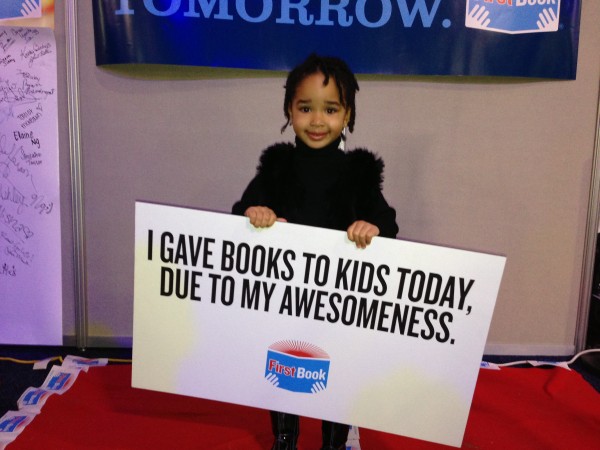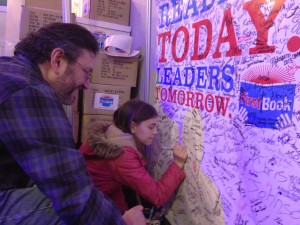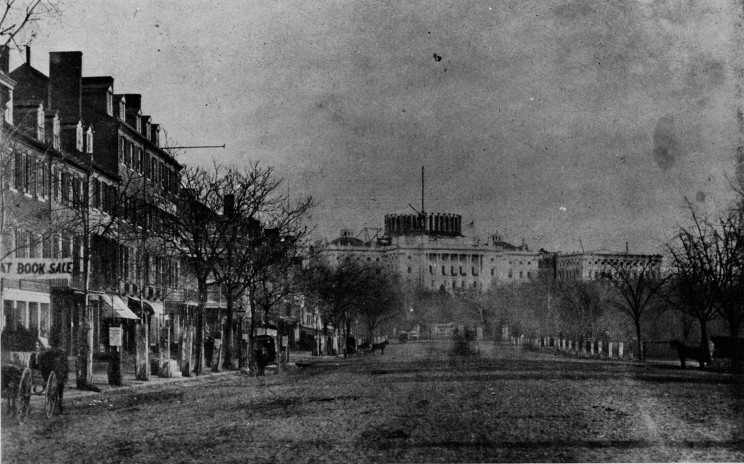
On Saturday, volunteers from across the country joined First Book on the National Mall in Washington DC to celebrate President Obama’s National Day of Service by providing 15,000 brand-new books to DC-area children from low-income families.
Click here to see photos of the event, including pictures of volunteers, political leaders, and even a few celebrities.
First Book was one of seven nonprofits featured at the event, highlighting the idea of community service in such areas as education, the environment and support for military families.
??Each volunteer packed two books into a bag, and decorated bookplates with personal messages.

The books, including “Martin’s Big Words: The Life of Dr. Martin Luther King, Jr.” by Doreen Rappaport, were provided thanks to the generous support of our friends at KPMG, the U.S. audit, tax and advisory firm, through its KPMG’s Family for Literacy program.
The bags will be distributed in the coming days to students throughout DC, thanks to First Book’s partnership with the American Federation of Teachers.

Even if you weren’t able to join us on the National Mall, you can still bring new books to kids in need. Click here to donate to our National Day of Service Virtual Book Drive. Every $2.50 provides one new books to a child in need.

By John Lockwood and Charles Lockwood
The Washington of April 1861—also commonly known as “Washington City”—was a compact town. Due to the cost of draining marshy land and the lack of reliable omnibus service, development was focused around Pennsylvania Avenue between the Capitol and White House. When the equestrian statue of George Washington was dedicated at Washington Circle in 1860, its location—three-quarters of a mile west of the White House, where Twenty-Third Street intersects Pennsylvania Avenue—was described as out of town. Several blocks north of the White House, at L Street, the land was countryside. “Go there, and you will find yourself not only out of town, away among the fields,” wrote English novelist Anthony Trollope in his travel account, North America, after his 1861 visit, “but you will find yourself beyond the fields, in an uncultivated, undrained wilderness.” A writer for the Atlantic Monthly, writing in January 1861, deemed Washington a “paradise of paradoxes,” foremost because it was both “populous” and “uninhabited” at once. Noting another paradox, he observed that the capital was ‘[d]efenceless, as regards walls, redoubts, moats, or other fortifications”—though the only party to “lay siege” to the city of late were the unyielding onslaught of politicians and office seekers, not soldiers.

Travelers arriving from northern cities caught a glimpse of the city’s grandeur and squalor as their train pulled into the B & O Station at the foot of Capitol Hill. “I looked out and saw a vast mass of white marble towering above us on the left . . . surmounted by an unfinished cupola, from which scaffold and cranes raised their black arms. This was the Capitol,” wrote Times of London correspondent William Russell, who arrived in Washington at the end of March 1861. “To the right was a cleared space of mud, sand, and fields, studded with wooden sheds and huts, beyond which, again, could be seen rudimentary streets of small red brick houses, and some church-spires above them.”
From the B & O Station, most carriages and hacks headed westward down Pennsylvania Avenue, the city’s main artery. The Avenue was the traditional route for grand parades between the Capitol and the White House, and by the mid-nineteenth-century, its north side was the location for the city’s finest hotels and shops. Yet many visitors, particularly those from leading cities like New York or London, were unimpressed by its pretensions to grandeur, and found the cityscape a formless jumble. Pennsylvania Avenue, observed Russell, was “a street of much breadth and length, lined with ailanthus trees . . . and by the most irregularly-built houses [and commercial buildings] in all kinds of materials, from deal plank to marble—of all heights.”

At the corner of Fourteenth Street, one block before Pennsylvania Avenue made its northward turn at the Treasury before continuing west past the White House, stood Willard’s Hotel. The hotel, favored by Republican Party leaders, was the center of Washington’s social and business life under the new administration. Willard’s contained “more scheming, plotting, planning heads, m







